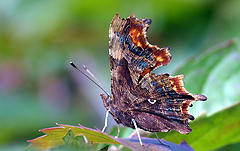This week I have had two proofreading gigs (actually, one gig and one test that may become a gig–keep your fingers crossed for me!) that have severely strained my comma rule knowledge. I’m proud to say that I know mostly by “feel” where to put the little buggers, but again, that doesn’t cut it in a newsroom.

News to me: The comma is a type of butterfly! flickr:Webmink.
The trusty AP Stylebook says under “essential clauses, nonessential clauses” (a bugbear for me when it comes to punctuation) that those terms are used “instead of restrictive clause and nonrestrictive clause to convey the distinction between the two in a more easily remembered manner.” I don’t know about you, but NONE of those words mean anything to me. I must have been sleeping during the sentence diagramming part of English class.
The example they give is:
“Reporters, who do not read the stylebook, should not criticize their editors.”
Versus:
“Reporters who do not read the stylebook should not criticize their editors.”
In one sentence only a certain class of reporters is being referred to; in the other, all reporters are included. Seems simple, right? Yet the only way I was able to make this stick was to come up with a new way of describing these clauses–as I said, “restrictive” and “essential” feel like bogus words.
So. An essential clause IDENTIFIES the subject. A nonessential clause further ELABORATES upon the subject. In other words (here’s the kicker), the first sentence could be split into two:
“Reporters do not read the stylebook. Reporters should not criticize their editors.”
Whereas the second sentence could not. Why I couldn’t find an explanation this simple on the Internet is beyond me, but this is what I had to do to get through the last two hours of work yesterday and escape an apoplexy.
0 Comments Leave a comment